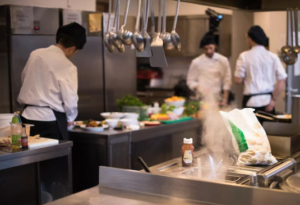Are you struggling to manage peak hours and busy periods in your restaurant? Do you find yourself overwhelmed by the influx of customers during certain times of the day or week? Don’t worry, you’re not alone.
Many restaurant owners and managers face the same challenges when it comes to handling high-volume orders and crowds.
In this article, we’ll give you some tips and tricks for successfully managing peak hours and busy periods in your restaurant. From staffing to equipment to customer service, we’ll cover all the important aspects of ensuring that your restaurant runs smoothly even during the busiest times.
So, sit back, relax, and get ready to learn how to handle the rush and keep your customers happy.

Staffing for Success: Ensuring Adequate Coverage During Busy Times
Make sure you’re staffing your restaurant appropriately during peak hours so your team can handle the rush without feeling overwhelmed.
One way to ensure that your staff is prepared for busy periods is through staff training. Train your team on how to handle high volume situations and emphasize the importance of teamwork during these times. Make sure everyone knows their role and responsibilities so that there’s no confusion or chaos when the rush hits.
Another important aspect of handling busy periods is scheduling strategies. You want to make sure that you have enough staff on hand to handle the volume of customers, but not too many that you’re overstaffed and wasting labor costs.
Consider implementing a flexible scheduling system where staff can sign up for additional shifts during peak hours. This allows for a more organic approach to staffing and ensures that you have enough coverage without putting too much strain on your budget.
Equipping Your Kitchen for High-Volume Orders
Ensuring your kitchen is furnished with appropriate commercial appliances is crucial to handle the increased volume of orders during peak hours. This includes investing in high-quality ovens, fryers, grills, and refrigerators that can handle a large number of orders simultaneously.
It’s also important to consider the size of your kitchen and the layout of your equipment to ensure maximum efficiency and productivity.
Aside from having the right equipment, inventory management is also key to keeping up with high-volume orders. This means regularly checking stock levels and ordering ingredients and supplies in advance to avoid running out of essential items.
It also entails organizing the kitchen and keeping it clean and tidy to prevent any delays or confusion during busy periods.
By equipping your kitchen with appropriate appliances and implementing effective inventory management strategies, you can ensure that your restaurant runs smoothly during peak hours and satisfies the demand of your customers.
Managing Reservations and Waitlists Effectively
Managing reservations and waitlists effectively can be a challenge, but it’s crucial for providing a seamless dining experience for your customers.
One way to streamline the process is by offering online booking. This not only allows customers to make reservations at their convenience but also reduces the workload of your staff. Make sure to update your online reservation system regularly, so customers can see the available time slots and reserve accordingly.
Another important aspect of managing reservations and waitlists is having a clear walk-in policy. Set expectations for your customers by clearly communicating your seating policies. This can include the maximum wait time, how the waitlist works, and how seating priority is determined.
By being transparent and consistent, you can avoid misunderstandings and ensure that your customers feel valued and respected.
Additionally, consider using a waitlist management app that allows customers to check their place in line and receive updates on their estimated wait time. This can help improve the customer experience and reduce the stress on your staff.
Communicating with Your Staff During Peak Hours
When it’s packed and orders are flying, you need to be able to communicate with your team seamlessly to ensure a smooth service and happy customers. One of the most effective ways to do this is by keeping your staff motivated.
During peak hours, it’s easy for your team to feel overwhelmed and stressed out. This can lead to a decrease in productivity and overall morale. To combat this, make sure to take the time to motivate your staff and boost their confidence. This can be done by praising them for their hard work, offering incentives for exceptional performance, and providing constructive feedback when necessary.
Another crucial aspect of handling busy periods in your restaurant is time management techniques. This involves properly delegating tasks and ensuring that everyone is working efficiently. One way to do this is by having a clear understanding of each staff member’s strengths and weaknesses. Assign tasks based on each person’s strengths to maximize efficiency.
Additionally, it’s important to have a system in place for prioritizing orders and ensuring that they are completed in a timely manner. This can involve using technology to streamline the ordering process or implementing a communication system that allows for real-time updates.
By effectively communicating with your team and utilizing time management techniques, you can successfully handle peak hours and keep your customers happy.
Providing Exceptional Customer Service During Busy Periods
To provide exceptional customer service during the rush, you’ll need to stay organized and work as a team to keep up with the influx of orders and customers. This means training your staff to efficiently handle busy periods and streamlining processes to avoid delays.
Start by identifying the busiest times in your restaurant and scheduling enough staff to handle the rush. Make sure each member of your team knows their role and understands the importance of communication and teamwork during these peak hours. To streamline processes, consider implementing technology such as digital ordering systems or mobile payment options. This can help reduce wait times and improve the overall customer experience.
Additionally, make sure your kitchen is organized and well-stocked with necessary supplies to avoid delays in preparing orders. By taking these steps to prepare for busy periods, you can ensure that your customers receive exceptional service and leave your restaurant satisfied.
Keeping your employees motivated and engaged is crucial to their job satisfaction and your overall success in peak days. Link
Frequently Asked Questions
How can I incentivize my staff to work during peak hours?
Encourage employee retention by offering incentives during staff scheduling. Consider bonuses, flexible hours, and recognition for exceptional work. Communicate the importance of their role during peak hours and the positive impact it has on the business.
What are some common mistakes restaurant owners make during busy periods?
During busy periods, restaurant owners often make mistakes like understaffing or overcomplicating menu items. This can lead to poor staff management and dissatisfied customers. Keep things simple, communicate effectively, and prioritize customer satisfaction.
How can I train my staff to handle difficult customers during busy times?
Train your staff in customer service to handle difficult customers during busy times. Teach de-escalation techniques like active listening, empathy, and patience. These skills will help maintain positive relationships and prevent negative reviews.
What strategies can I use to reduce wait times for customers without sacrificing quality?
Reduce wait times and maintain quality by implementing online ordering and encouraging table turnover. Streamline processes, prioritize orders, and optimize staffing. Keep customers informed and engaged with wait time estimates and promotions.
How can I keep my kitchen staff motivated and efficient during long shifts?
To keep your kitchen staff motivated and efficient during long shifts, try team building activities and time management skills. Encourage breaks, provide clear instructions and feedback, and acknowledge their hard work to maintain a positive work environment.
Conclusion
Now that you’ve learned about how to handle peak hours and busy periods in your restaurant, it’s time to put your knowledge into action.
Remember, staffing is key to ensuring that your restaurant runs smoothly during busy times. Make sure you have adequate coverage and that your kitchen is equipped to handle high-volume orders.
Managing reservations and waitlists effectively is also crucial. Communicating with your staff during peak hours is important to ensure everyone is on the same page and working towards the same goals.
And finally, providing exceptional customer service during busy periods is what will set your restaurant apart from the competition. With these tips in mind, you can handle even the busiest of times with ease and keep your customers happy.
Good luck!



